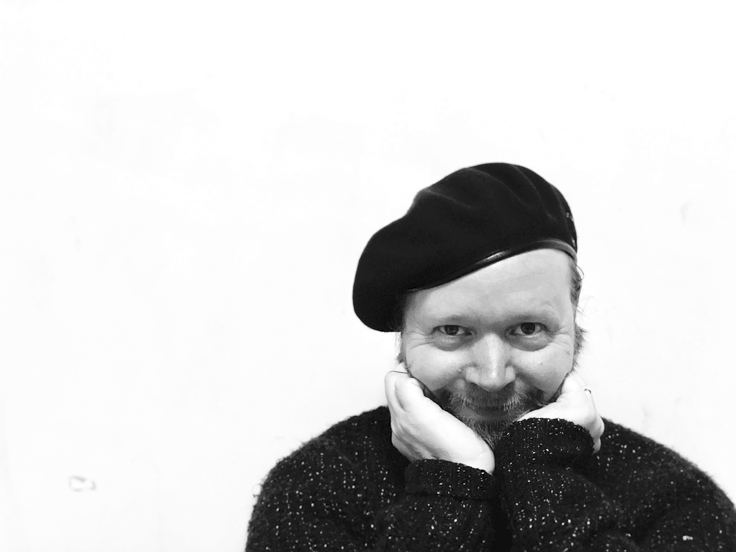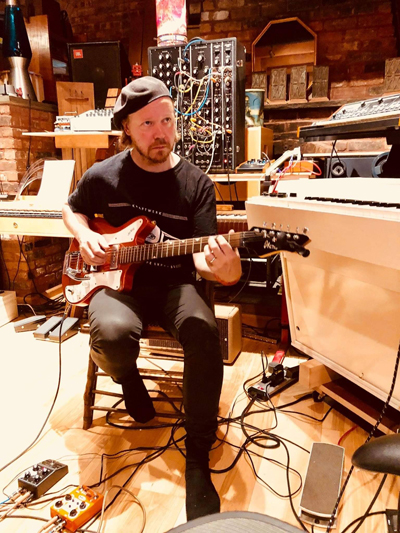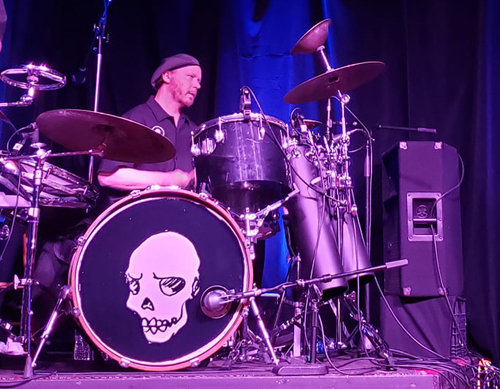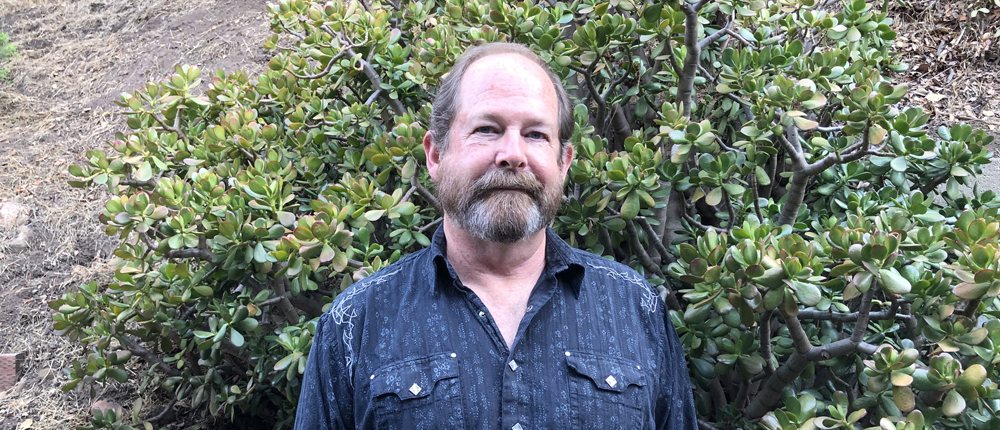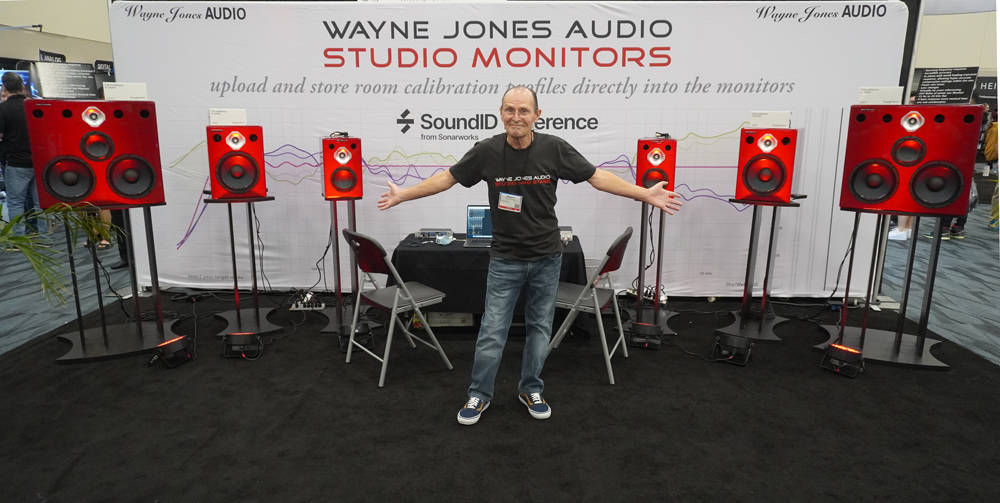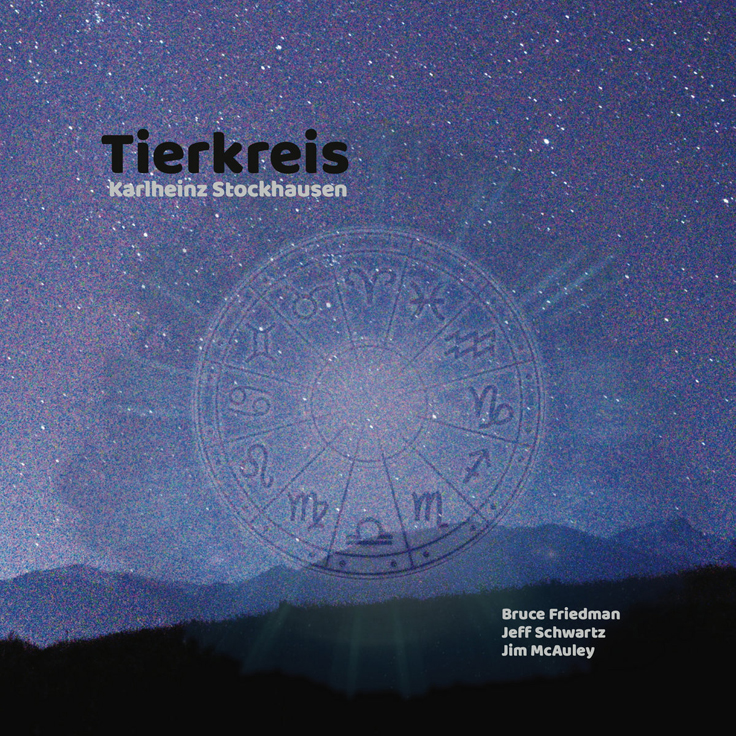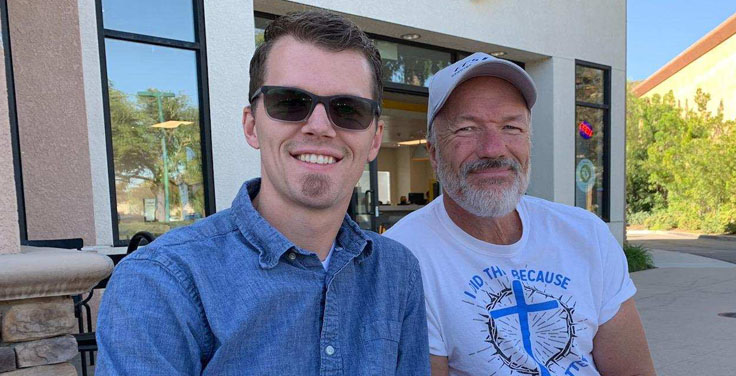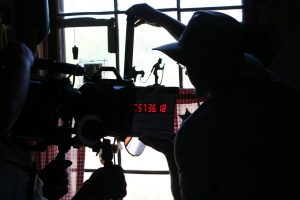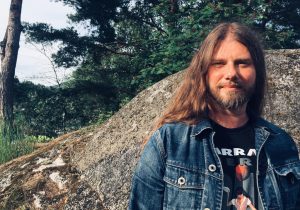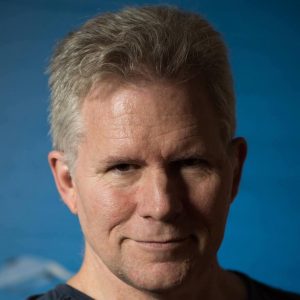Mattias Olsson - Photo by Vincent Carild - Used with permission
Mattias Olsson is perhaps best known as the drummer for the Swedish progressive rock band, Änglagård. Currently, he's credited with some sort of involvement in nearly 150 projects. From his Roth Händle Studio outside Stockholm, he records and produces bands from all over the world, and composes and records tracks for his own projects. He's also touring regularly with several bands and, in his free time, writes for several Swedish publications.
How many groups are you currently working with?
I'm not quite sure. Döskalle, Pixie Ninja, The Devil's Staircase, Sofie Elezaj, Hemlin Gremlin, Il Tempio Delle Clessidre, Akaba, Molesome, Matti Bye, and Kinski Pop, a sort of art pop combo that are in constant change.
How do you keep all of this material straight in your mind?
I write notation but, generally, by the time I've written down arrangements, I have it in my head. It's the kind of thing that, when I see the notation, I remember the track. It's also the kind of notation that only I would understand. How I would describe the part isn't necessarily how anyone else would. For example, I can make a reference to another track with a similar beat, but won't write the song. There is a section with The Devil's Staircase that says Rage Against the Machine, but TDS obviously doesn't sound anything like Rage.
You started studying music quite early, and were quite serious about it.
In Sweden, everyone has to choose an instrument when they are 9, but I started school one year early. I chose drums. After a while I figured that music was the best thing in the world to do. When I was about 13 I started messing about with my brother's guitar. My mother used to administrate night courses for adults, like Spanish, knitting, and music. So I found my brother's guitar and The Complete Beatles book. The Beatles are the best band to learn from. You are learning at the same pace as they are, in a weird way. The first songs are pretty simple, and have just three or four chords, and then things start to get weird. I also had a great music teacher who was very generous with his time and knowledge. I have always been very lucky to have mentors who sort of nudged me in the right direction.
I started messing about on the guitar, and then when I was 19 and started playing with Pineforest Crunch, it was sort of presumed that everyone wrote songs, so I did. I was like the George Harrison of Pineforest Crunch, but without the sitar and the songs. On every PFC album I had one song. And then, when we started mixing the last album at EMI Studios [in Stockholm], I brought my little Porta-Studio and sat in the big room and made a lot of noise. I didn't really think about it. I probably had some kind of beat from home, and then did the overdubs there.
Then I started taking courses in electro-acoustic music at EMS to learn about modular synthesis and recording, which I didn't. I was mostly incredibly provoked by the whole thing, where incredibly talented musicians had to teach a course that was really naive and stupid and then, at the last lesson, they would play their own music and I was completely blown away, and realized that I had missed out on this amazing opportunity.
I started out messing with effect pedals. I had a tuner that was a tone generator, then I put that through a Seek Wah (a sort of wah tremolo thing), then an echo, and then through a tempo delay. A friend came by and said, "Do you know that you have just built a modular synth?" I was just making sounds, and I didn't have any real money. [Hear this early experiment.]
Mattias Olsson - Video of Pineforest Crunch Used with permission
Were these experiments part of your work with PFC, or just stuff you were doing on your own?
I was just making stuff up and then, when I started recording and producing bands, I realized that Molesome and my experiments were sort of my lab where I could mess up without spending anyone else's time. Then someone would come along and want a weird sound, and I would go "I have an idea..." Andreas & Jag was the first band I recorded, and it was incredibly liberating. Just me and my best friend making stuff up. Recording backing vocals through the answering machine because we liked the sound of the micro cassette. Doing tape loops on flea market tape machines. He wrote great pop songs, and I made them sound weird.
When I had been in bands previously, recording in big studios, everything seemed very fragile and precious. Sounds and songs could break if you weren't careful. So, when I got my own recording machine, I wanted to try everything that everyone said was bad or crappy. One classic thing was that you should never, EVER, use a spring reverb on a snare drum because it goes boinggg. Then you try it, and realize that it is THE sound of dub reggae. Also, recording in the apartment had it's limitations, and we had to try getting as many sounds as possible out of the gear we had.
What was your recording system?
I started of with a Akai DPS-12. Great machine! Then I upgraded to two 16s and then three 24s, so it's almost like the development of tape machines. They all have virtual tracks, so you can record almost infinitely, but you have to submix to play everything. I don't mind, as it forces you to make decisions and cement your sonic direction. That was one of the good things about recording on tape. You had to decide.
I still view the machines the same way. I try to get everything done as articulate as possible. I record pretty much everything with effects so that everything is recorded with that sound in mind so that you can balance everything as you go.
When you recorded in big studios, that was a big no-no. You always recorded everything as cleanly as possible, and then you messed it up afterwards, which meant that everything was recorded too big and massive. Then, the engineer sat and tried to EQ everything to make it all fit.
I think it was Pontus Olsson who told me that mixing is like trying to get two liters of water into a one liter bottle. He worked on the Pineforest Crunch albums as a mixer. Incredibly cool guy. Hated his job. Every day, he would walk in at EMI, see that Big SSL mixing console, and let out a deep sigh. And he was still one of the best engineers I've ever worked with.
I was that annoying kid always asking questions and making notes. I asked if I could be in the room when he set up a mix, and he said that I could if he didn't hear or see me. So I sort of hid in a couch in the back of the room and heard how he methodically EQ'd everything so that it all fit. He always thought young musicians were wasting his time, which was kind of weird considering that we were paying him. He thought there should be a token machine for the electricity in studios that you fed with ten dollar tokens. An hour at EMI cost around 150 dollars, so you would need one band member feeding the token machine constantly like an old British hotel shower, or motel TV. He was kind of fed up waiting for kids to tune their guitars. Changing batteries and tuning for 150 dollars an hour.
Did those experiences inform how you charge for your time in your own studio?
I don't think that stress helps in any way. I prefer setting up sessions so that you record a couple of songs, or you have set prices. Having people stressing out, looking at their watches, isn't creative in any way. Recording with Änglagård taught me a lot about how NOT to record an album. You would fuck up and Tord [Lindman] would storm into the room and tell you exactly how much your mistake had cost the band. "GET YOUR SHIT TOGETHER. YOU ARE WASTING OUR MONEY."
With PFC it was more like, "Here is this huge studio for a month. Record the album." We'd roll in our gear and get to work. We weren't mucking about but having the room was just amazing.
Because you value experimentation, and your studio certainly lends itself to experimentation, you probably want to allow for your clients to have that opportunity.
Yes, but a lot of the time it's about trying to understand what the artist is going for. I recorded the French band Blanc and they wanted to have an organ on a section. I asked them what kind of organ they were looking for, and the singer, Stephan, replied, "it should sound like a morning." And I was like, "Ok, like a misty morning in Scotland, or on a beach watching the sun go up?" We started with one organ, and then another, and then we hooked up a Leslie [a rotating speaker]. Fast Leslie, and then slow Leslie. A bit of distortion. A lot of distortion. Echo units. Tempo delays. Analaog delay. Tape delay. At the end we had recorded 32 different organs. They took all the files back to Paris and started putting together their morning, starting with 80% of #17, with a splash of #24, or maybe #4 in the left speaker, #31 in the right, and then the effect return of #13.
I never do that. I always only record what I need. I like painting myself into a corner and then I figure it out afterwards.
There's a solid logic to that approach.
It's easier to get it right from the beginning. If it doesn't sound right when you are recording something, you are going to spend a lot more time trying to fix it later. Its more laziness and experience than a modus operandi.
Mixing is made easier when one has a good musical arrangement.
Oh yes. A lot of my job is to make difficult things sound easy. I want the listener to trust me, and then I'll take them on a stroll through the song or album. I'll show them some cool places, and then I'll drop them off somewhere nice. It might get a bit aggressive and loud now and then, but they will be OK.
Mattias Olsson - Photo by Tom Doncourt - Used with permission
The Molesome album, Dial, was like that. To me, it felt simultaneously organic and highly constructed, which was surprising and delightful.
I like the new one, Be My Baby Tonight, too. There are some asshole songs on there, but they needed a place to stay. Dial was like that because it was done very fast, and then I sort of forgot about it for 16 years or whatever. I make a lot of stuff, and I don't trust my own judgement at all when it comes to good or bad. I had a British manager, and we loved hanging out at bars in Camden, drinking beer, and having endless discussions about music and art. He would always say that the thing that makes art 'art' is the framing. So I'll put a bunch of these orphaned musical ideas on a plastic disc and, all of a sudden, its an album! Right?
You've worked with Ketil Vestrum Einarsen on a number of projects. When you started on the first Weserbergland album, Sehr Kosmisch, Ganz Progisch, how did your parts come together?
He sent me a mix with some guide drums, and I was very much into the idea of rhythmic modules and looping myself, organically. We were in the same place, oddly enough. Jacob [Holm Lupo] deserves a lot of credit, as well. The drums sound amazing on that thing.
How would you describe the material on that first record?
It's this weird mosaic moving in and out of focus in some very choreographed way.
When Ketil approached you to work on the new album, what were you told?
I think I got in touch with him. The Norwegians are very peculiar.
In what way are the Norwegians peculiar?
You never know if you are in the band or not.
I asked Gaute Storsve, guitarist and long-time collaborator with Ketil, about this. He said, "Its because of all the mountains."
The first Weserbergland album was very much Ketil's baby, with added bits and pieces. Then I played on the second one and then, all of a sudden, the second one was the third one because he was doing this other one in between. So, he tells me I'm only allowed to do one sound or instrument. Ok. He cheated with computer. [Ketil chose the computer as his one instrument. -srw] So I thought, "well, I can do turntable stuff." That means I can do any sounds that I have on vinyl. Resampled and messed with. There might be a lot of distorted birds and Morroccan chanting on that one.
My idea was that I would add some kind of timeline to the thing because it's easy to get lost, so I did a sort of sonic map, and then Ketil cut it up and threw up in the air and put it back together. I have NO idea where the treasure is buried, now. Thanks, Ketil.
So, what's next for you?
I'm in the middle of finishing the new Pixie Ninja album. Then there is the Molesome Piano album. I'm finishing mine and Tom's Cathedral thing. Then we have the Döskalle studio album, and then the Necromonkey album.
Döskalle released their first album, a live album, not long after the band formed. How did that happen?
We weren't really planning on releasing the live thing as our first album. It felt like a logical thing to do as nothing was really planned or mapped out. We might as well do everything ass backwards.
Döskalle by Kristi Gibson Pozza - Used with permission
Explain the band, if you will?
It all started with Tobias Alpadie (guitar) and Hampus Nordgren-Hemlin (Bass) sitting at a bar, or at an after party talking about starting a band together. They had known each other from music school. During one of these late night sessions, probably Tobias, blurted out, "and we are called DÖSKALLE." So it became this running joke I, guess, about this band Döskalle.
I started DJing at a hotel bar where Tobias worked, and we really had too much fun together, so he mentioned this friend, and this band. And I was like, "Sure. Come by the studio and well make up some songs." So we started. Made some songs. One of them is an idea I did for Necromonkey that I sent to David [Lundberg] that he never listened to.
We are all prog fans but in a kind of tongue in cheek way.
What do you mean?
Well, we had a sound collage called Prog Death that was played before the shows, and a letter that was handed out to the audience.
[The collage, which is not available for listening due to the legal challenge of acquiring all the necessary clearances, includes snippets from The Beatles, Genesis, Peter Gabriel, The American Hipster Language, Rush, Pink Floyd, Ray Parker Jr, and Yes. These snippets are not exactly arranged as an homage but, rather, as a bit of a send-up. If you're a serious fan of progressive rock, you might feel a bit miffed.]
This is too funny! Did you play your Death Prog track at ProgToberFest?
Oh yes...before every show. Its our thing. And then, for the next tour, we'll do a new one.
Do you have anything else in the works?
I'm toying with doing a choir piece next. The idea is that you have maybe ten singers, and each has a CD Walkman, and headphones. A series of notes are played on the CD and the singer sings the notes without hearing the other singers. I also have recorded vocal instructions about the volume, or movements. No one rehearses, and the choir performs a piece they have never heard and, after the show, they still have no idea of what it sounded like. I like the idea of doing a symphonic piece where everyone performs in parallel. I also have the idea of doing things with a distant orchestra, or a second choir walking in, or hiding singers in the audience. If everyone just presses 'play' at the exact right time it'll be fine. That would be the job of the conductor. I also like the fact that one CD could be quiet for 5 minutes, with no instructions, or telling a joke. No one will no how it was supposed to be. Well, I would know.
Subscribe to the Roth Handle channel on YouTube.
Watch Pineforest Crunch live in Japan.




